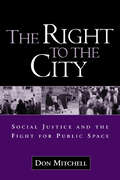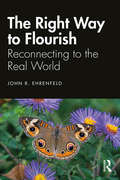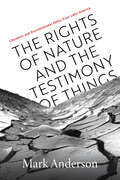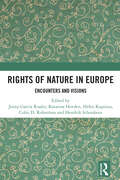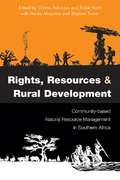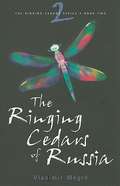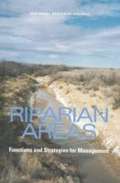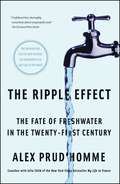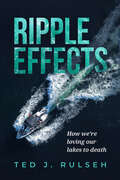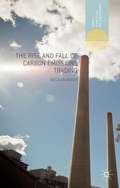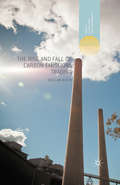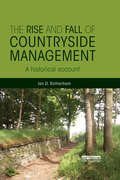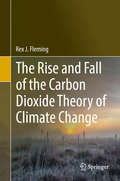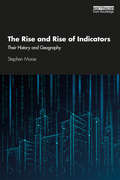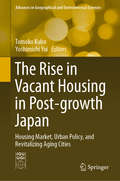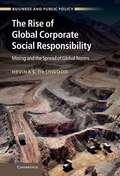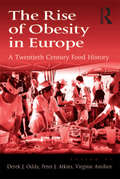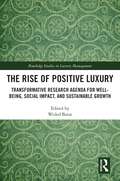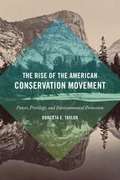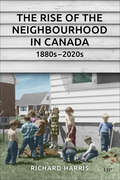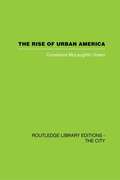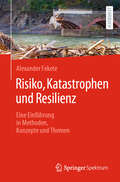- Table View
- List View
Right to the City: Social Justice and the Fight for Public Space
by Don MitchellIn the wake of recent terrorist attacks, efforts to secure the American city have life-or-death implications. Yet demands for heightened surveillance and security throw into sharp relief timeless questions about the nature of public space, how it is to be used, and under what conditions. Blending historical and geographical analysis, this book examines the vital relationship between struggles over public space and movements for social justice in the United States. Presented are a series of linked cases that explore the judicial response to public demonstrations by early twentieth-century workers, and comparable legal issues surrounding anti-abortion protests today; the Free Speech Movement and the history of People's Park in Berkeley; and the plight of homeless people facing new laws against their presence in urban streets. The central focus is how political dissent gains meaning and momentum--and is regulated and policed--in the real, physical spaces of the city.
The Right Way to Flourish: Reconnecting to the Real World
by John EhrenfeldIn this ground-breaking book, pre-eminent thought leader in the fields of sustainability and flourishing, John R. Ehrenfeld, critiques the concept of sustainability as it is understood today and which is coming more and more under attack as unclear and ineffective as a call for action. Building upon the recent work of cognitive scientist, Iain McGilchrist, who argues that the human brain’s two hemispheres present distinct different worlds, this book articulates how society must replace the current foundational left-brain-based beliefs – a mechanistic world and a human driven by self interest – with new ones based on complexity and care. Flourishing should replace the lifeless metrics now being used to guide business and government, as well as individuals. Until we accept that our modern belief structure is, itself, the barrier, we will continue to be mired in an endless succession of unsolved problems.
The Rights of Nature and the Testimony of Things: Literature and Environmental Ethics from Latin America
by Mark AndersonThe Rights of Nature and the Testimony of Things begins by analyzing the ethical debates and political contexts relating to Latin American &“rights of nature&” legislation and the political ontology of nonhuman speech within a framework of intercultural and multispecies diplomacy. Author Mark Anderson shows how Latin American authors and thinkers complicate traditional humanistic perspectives on nature, the social, and politics, exploring how animals, plants, and environments as a whole might be said to engage in social relations and political speech or self-representation. Drawing Native Amazonian thought into productive tension with a variety of posthumanist theoretical frameworks—ranging from Derrida&’s conceptualization of passive decision and hospitality to biosemiotics, Karen Barad&’s theorization of intra-activity, and Isabelle Stengers&’ proposal for cosmopolitical diplomacy—Anderson analyzes literary works by Julio Cortázar, Clarice Lispector, José Eustasio Rivera, and Davi Kopenawa that reframe environmental ethics in terms of collective, multispecies work and reciprocal care and politics as a cosmopolitics of friendship rooted in diplomacy across difference. Finally, Anderson examines the points of connection and divergences between Latin American relational ontologies and Euro American posthumanist theories within Indigenous Latin American remodernization projects that reappropriate and repurpose ancestral practices as well as develop new technologies with the goal of forging alternative modernities compatible with a livable future for all species.
Rights of Nature in Europe: Encounters and Visions
by Jenny García Ruales Katarina Hovden Helen Kopnina Colin D. Robertson Hendrik SchoukensThis book addresses the recognition of the Rights of Nature (RoN) in Europe, examining their conceptualisation and implementation. RoN refers to a diverse set of legal developments that seek to redefine Nature's status within the law, gradually emerging as a novel template for environmental protection. Countries like Ecuador and New Zealand, each with distinct histories and ways of dwelling in the world, have pioneered a new era in environmental governance by legally acknowledging rights or personhood for nature, ecosystems, and more-than-human populations.In recent years, Europe has witnessed growing interest in RoN, with academic, legislative, and political initiatives gaining momentum. A significant development is the September 2022 passage of a law in the Spanish Parliament, granting legal personhood and rights to the Mar Menor, a saltwater lagoon severely affected by environmental degradation.Given the diversity in interpretations and articulations of ‘Rights of Nature’, this edited volume argues that their arrival in Europe fosters different kinds of interactions across distinct areas of law, knowledge, practices, and societal domains. The book employs a multidisciplinary approach, exploring these interactions in law and policy, anthropology, Indigenous worldviews and jurisprudence, philosophy, spiritual traditions, critical theory, animal communication, psychology, and social work.This book is tailored for scholars in law, political science, environmental studies, anthropology and cultural studies; as well as legal practitioners, NGOs, activists and policy-makers interested in ecology and environmental protection.
Rights Resources and Rural Development: Community-based Natural Resource Management in Southern Africa
by Christo Fabricius Eddie Koch Hector Magome Stephen TurnerCommunity-based natural resource management (CBNRM) is an approach that offers multiple related benefits: securing rural livelihoods; ensuring careful conservation and management of biodiversity and other resources; and empowering communities to manage these resources sustainably. Recently, however, the CBNRM concept has attracted criticism for failing in its promise of delivering significant local improvements and conserving biodiversity in some contexts. This book identifies the flaws in its application, which often have been swept under the carpet by those involved in the initiatives. The authors analyse them, and propose remedies for specific circumstances based on the lessons learned from CBNRM experience in southern Africa over more than a decade. The result is essential reading for all researchers, observers and practitioners who have focused on CBNRM in sustainable development programmes as a means to overcome poverty and conserve ecosystems in various parts of the globe. It is a vital tool in improving their methods and performance. In addition, academics, students and policy-makers in natural resource management, resource economics, resource governance and rural development will find it a very valuable and instructive resource.
Ring of Fire
The Ring of Fire is a place where volcanoes ooze lava or blow their tops in powerful explosions. it's a place where earthquakes topple buildings or create monster waves. Where is this place? What causes these earthshaking events? You'll find out in this book!
The Ringing Cedars of Russia (The Ringing Cedars Series #2)
by Vladimir Megré John Woodsworth Leonid SharashkinAfter rising rapidly to the top of national best-seller lists, first-time author Vladimir Megre has some explaining to do.
Riparian Areas: Functions and Strategies for Management
by Committee on Riparian Zone Functioning Strategies For ManagementThe Clean Water Act (CWA) requires that wetlands be protected from degradation because of their important ecological functions including maintenance of high water quality and provision of fish and wildlife habitat. However, this protection generally does not encompass riparian areas--the lands bordering rivers and lakes--even though they often provide the same functions as wetlands. Growing recognition of the similarities in wetland and riparian area functioning and the differences in their legal protection led the NRC in 1999 to undertake a study of riparian "areas, which has culminated in Riparian Areas: Functions and Strategies for Management. The report is intended to heighten awareness of riparian areas commensurate with their ecological and societal values. The primary conclusion is that, because riparian areas perform a disproportionate number of biological and physical functions on a unit area basis, restoration of riparian functions along America's waterbodies should be a national goal.
The Ripple Effect
by Alex Prud'HommeNow in paperback from the bestselling coauthor with Julia Child of My Life in France "a balanced and insightful assessment of what could emerge as the dominant issue in decades ahead" (Associated Press)--the fate of fresh water in the twenty-first century.With The Ripple Effect, Alex Prud'homme has changed the way we think about the water we drink. Inspired by an interest in our worldwide obsession with bottled water, Prud'homme undertook an ambitious quest to understand the evolving story of freshwater. What he found was shocking: as the climate warms and world population grows, demand for water has surged, but supplies of fresh water are static or dropping, and new threats to water quality appear every day. The questions he sought to answer were urgent: Will there be enough water to satisfy demand? What are the threats to its quality? What is the state of our water infrastructure--both the pipes that bring us fresh water and the levees that keep it out? How secure is our water supply from natural disasters and terrorist attacks? Can we create new sources for our water supply through scientific innovation? Is water a right like air or a commodity like oil--and who should control the tap? Like Daniel Yergin's seminal classic The Prize: The Epic Quest for Oil, Money, & Power, The Ripple Effect is a masterwork of investigation and a dramatic narrative, spanning from the alleged murder of a water scientist in New Jersey to the epic confrontation between salmon fishermen and copper miners in Alaska. The Ripple Effect is a major achievement and will change our understanding of the importance of water forever. el Pollan has changed the way we think about the food we eat; Alex Prud'homme will change the way we think about the water we drink. Informative and provocative, The Ripple Effect is a major achievement.
Ripple Effects: How We're Loving Our Lakes to Death
by Ted J. RulsehLakes are among the Upper Midwest’s greatest treasures and most valuable natural resources. The Great Lakes define the region, and thousands of smaller lakes offer peace, joy, and recreation to millions. And yet, in large part because of the numbers of people who enjoy the local waterways, the lakes of Wisconsin, Michigan, and Minnesota face numerous challenges. Invasive species, pollution, defective septic systems, inadequate shoreland zoning laws, and climate change are present and increasingly existential threats. We are, quite possibly, loving our lakes to death. In his engaging and conversational style, Ted Rulseh details each of these challenges and proposes achievable solutions. He draws on personal experience, interviews, academic research, and government reports to describe the state of the lakes, the stresses they are under, and avenues to successful lakeside living for a sustainable future. Ripple Effects will be a go-to source for all who love lakes and who advocate for their protection; its driving question is summed up by one of Rulseh’s interviewees: “We love this lake. What can we do to keep it healthy?”
The Rise and Fall of Carbon Emissions Trading (Energy, Climate and the Environment)
by Declan KuchThe Rise and Fall of Carbon Emissions Trading.
The Rise and Fall of Carbon Emissions Trading (Energy, Climate and the Environment)
by Declan KuchThis book presents the results of the first full-scale emissions trading schemes in Australia and internationally, arguing these schemes will not be sufficient to 'civilize markets' and prevent dangerous climate change. Instead, it articulates the ways climate policy needs to confront the collective nature of our predicament.
The Rise and Fall of Countryside Management: A Historical Account
by Ian D. RotherhamFor at least half a century since the emergence of Country Parks and Forest Parks, countryside services have provided leisure, tourism, conservation, restoration and regeneration across Britain. Yet these services are currently being decimated as public services are sacrificed to the new era of austerity. The role and importance of countryside management have been barely documented, and the consequences and ramifications of cuts to these services are overlooked and misunderstood. This volume rigorously examines the issues surrounding countryside management in Britain. The author brings together the results of stakeholder workshops and interviews, and in-depth individual case studies, as well as a major study for the Countryside Agency which assessed and evaluated every countryside service provision in England. A full and extensive literature review traces the ideas of countryside management back to their origins, and the author considers the wider relationships and ramifications with countryside and ranger provisions around the world, including North America and Europe. The book provides a critical overview of the history and importance of countryside management, detailing the achievements of a largely forgotten sector and highlighting its pivotal yet often underappreciated role in the wellbeing of people and communities. It serves as a challenge to students, planners, politicians, conservationists, environmentalists, and land managers, in a diversity of disciplines that work with or have interests in countryside, leisure and tourism, community issues, education, and nature conservation.
The Rise and Fall of the Carbon Dioxide Theory of Climate Change
by Rex J. FlemingThis book provides a complete review of the role of CO2 in the Earth’s atmosphere and reveals detailed information about the subject of climate change. Many different science disciplines are visited and discussed and each area is introduced with a brief summary written to appeal to a broader audience. The logic of CO2 involvement in changing the climate is investigated from every perspective: reviewing the historical data record of Ice Ages with vast ice sheets, noting the interglacial periods of little or no ice, examining in further detail the 20th century data record and evaluating the radiation role of CO2 in the atmosphere. The radiation calculations, using the appropriate equations and data are reviewed in great detail. The results of this review and examination reveal no role of CO2 in any change of the Earth’s climate. Disclaimer: The views expressed in this book belong solely to the author.
The Rise and Rise of Indicators: Their History and Geography
by Stephen MorseThis book makes indicators more accessible, in terms of what they are, who created them and how they are used. It examines the subjectivity and human frailty behind these quintessentially ‘hard’ and technical measures of the world. To achieve this goal, The Rise and Rise of Indicators presents the world in terms of a selected set of indicators. The emphasis is upon the origins of the indicators and the motivation behind their creation and evolution. The ideas and assumptions behind the indicators are made transparent to demonstrate how changes to them can dramatically alter the ranking of countries that emerge. They are, after all, human constructs and thus embody human biases. The book concludes by examining the future of indicators and the author sets out some possible trajectories, including the growing emphasis on indicators as important tools in the Sustainable Development Goals that have been set for the world up until 2030. This is a valuable resource for undergraduate and postgraduate students in the areas of economics, sociology, geography, environmental studies, development studies, area studies, business studies, politics and international relations.
The Rise in Vacant Housing in Post-growth Japan: Housing Market, Urban Policy, and Revitalizing Aging Cities (Advances in Geographical and Environmental Sciences)
by Tomoko Kubo Yoshimichi YuiThis book explores how Japanese cities have transformed since the 1950s by describing housing and urban planning policies, urbanization processes, and maps with GIS analysis. It also discusses how housing vacancies have increased in shrinking Japanese cities, with case studies in Tokyo, Kyoto, Hiroshima, and Utsunomiya, and examines public–private partnerships and civil engagement to revitalize cities. Providing examples of how Japanese cities have addressed the issues of aging populations and urban shrinkage, it contributes to better decision-making by politicians, planners, local authorities, NPOs, and local communities in many rapidly urbanizing and potentially aging regions such as Asia.In the era of urban shrinkage, Japanese cities have struggled with aging populations, low fertility, population loss, and a decline in the economic base over decades. In particular, shrinkage in metropolitan suburbs and large cities (e.g., sites of prefectural government with 300 000–400 000 inhabitants) has caused serious social problems owing to the huge aging population and large areas covered. One typical problem that has emerged is an increase in vacancies in now empty and abandoned housing.
The Rise of Autonomous Smart Cities: Technology, Economic Performance and Climate Resilience (Sustainable Urban Futures)
by Zaheer AllamThis book introduces the concept of the ‘autonomous city’- a concept that has been developed from the ‘smart cities’ model that is based on a city’s ability to gather data and taking it one step further. The digital revolution has brought about numerous changes in the urban realm, along with the understanding that technology can aid in increasing the performance and efficiency of urban areas. This technology has given rise to a wealth of data allowing urban leaders to respond better to crisis and craft policies that increase the liveability of urban areas. The ‘autonomous city’ explores the possibility of urban areas evolving from the dimension of data gathering to that of action response – so a city able to collect data and render real time decisions to self-manage a variety of functions based on its interpretation of that data. The book discusses how this could lead to the automation of select urban dimensions for increased efficiency and performance, but also details how such a process would require careful consideration when put into practice. This book will be a valuable resource for scholars and students across Urban Planning, Sustainability and STS, as well as practitioners and policy makers involved in the development of urban life.
The Rise of Global Corporate Social Responsibility
by Hevina S. DashwoodCombining insights from international relations theory with institutional approaches from organization theory and public policy, this book provides a complete explanation for the adoption of Corporate Social Responsibility (CSR), showing how global norms influenced CSR adoption in the mining industry. Global normative developments have clearly had an important influence on major mining companies: by the mid 2000s the majority had adopted sustainable development as a normative frame for their CSR policies and practices. However, there is significant variation between firms in terms of the timing, degree of commitment and the willingness to assume a leadership role in promoting global standards for the mining industry. The author finds that attributes internal to the firm, including the critical role of leadership, and the way in which management responds to the institutional context and operational challenges faced in different countries are important influences on CSR adoption and important factors explaining variation.
The Rise of Obesity in Europe: A Twentieth Century Food History
by Derek J. OddyTwentieth century Europe went through a dramatic transition from low income populations experiencing hunger and nutritionally inadequate diets, to the recent era of over-consumption and growing numbers of overweight and obese people. By examining the trends in food history from case studies across Europe, this book offers a historical context to explain how and why this transition has occurred and what we can learn in order to try and address the vitally important issues arising from obesity in contemporary Europe.
The Rise of Positive Luxury: Transformative Research Agenda for Well-being, Social Impact, and Sustainable Growth (Routledge Studies in Luxury Management)
by Wided BatatOffering a holistic approach to positive luxury, this comprehensive book provides a novel framework grounded in the new paradigm of Transformative Luxury Research (TLR) stream. TLR helps luxury businesses and researchers develop in-depth knowledge about the mechanisms and factors that shape the future of positive luxury thinking and doing while promoting collective and individual well-being outcomes, social justice, eco-friendly practices, and sustainable growth, involving various stakeholders, communities, and institutions across developed and developing countries. Through a wide range of empirical, methodological, and theoretical contributions, examining the social, environmental, organizational, political, and cultural issues in responsible luxury marketing, this book explores the relationship between luxury consumption, production, and well-being outcomes. It offers a comprehensive overview of how luxury businesses can transform their practices and thus play an active role in promoting positive luxury within the industry and beyond along with enhancing their competitiveness, innovation, and profitability. The idea of well-being outcomes and sustainable growth, as applied in the TLR agenda, calls for synergistic theoretical and practical approaches. The content of this book, through different exciting chapters, will generate novel ideas to promote positive luxury business models leading luxury firms to transform their practices by advancing the current understanding of ethical and responsible business practices, which contribute to individual and collective well-being within the luxury field.
The Rise of the American Conservation Movement: Power, Privilege, and Environmental Protection
by Dorceta E. TaylorIn this sweeping social history Dorceta E. Taylor examines the emergence and rise of the multifaceted U.S. conservation movement from the mid-nineteenth to the early twentieth century. She shows how race, class, and gender influenced every aspect of the movement, including the establishment of parks; campaigns to protect wild game, birds, and fish; forest conservation; outdoor recreation; and the movement's links to nineteenth-century ideologies. Initially led by white urban elites--whose early efforts discriminated against the lower class and were often tied up with slavery and the appropriation of Native lands--the movement benefited from contributions to policy making, knowledge about the environment, and activism by the poor and working class, people of color, women, and Native Americans. Far-ranging and nuanced, The Rise of the American Conservation Movement comprehensively documents the movement's competing motivations, conflicts, problematic practices, and achievements in new ways.
The Rise of the Neighbourhood in Canada, 1880s–2020s
by Richard HarrisNeighbourhoods matter now more than ever before. They sustain fewer social connections, but in an era of great social inequality and high levels of immigration, they have become vital as places for homeowner investment and educational opportunity for children. The Rise of the Neighbourhood in Canada, 1880s–2020s traces the changing character and significance of Canadian urban neighbourhoods, city and suburban, since the 1880s. The book highlights patterns in neighbourhood life, particularly noticeable in larger urban areas, which are especially important for the least mobile people: workers, lower income households, immigrants, women, children, and the elderly. It explores how the physical and social characteristics of neighbourhoods affect public health, crime rates, social capital, and job opportunities while shaping the lifelong prospects of children. Analysing long-term trends, the book examines the importance of communications technology in the context of rising inequality and immigration. It shows how, as homeownership rose, neighbourhoods became vital settings for investment, increasingly financialized, reducing affordability. Using examples from all types of neighbourhoods in cities small and large, from St. John’s through Montreal and Winnipeg to Victoria, The Rise of the Neighbourhood in Canada argues that the current prominence of neighbourhoods will persist.
The Rise of Urban America
by Constantine McLaughlin GreenThe rise of cities in the United States from the early seventeenth century to the 1960s is the subject of this sophisticated and witty appraisal by a Pulitzer Prize historian. Constance McLaughlin Green traces the forces - economic, political, social - that led to today's urban civilization, beginning with the growth of colonial seaports and local government, the rise of new cities that competed for wealth and power with the older cities, the spread of industrialization, transportation and communications that made complex city life possible. She discussed the influence of city life on art and architecture, the impact of depression and prosperity upon urban centres, and analyses present-day problems - race-relations, the population explosion, automation, the rise of suburbia, and the development of the 'megapolis' that links city with city in one vast urban interstate region. This book was first published in 1966.
Risiko Energiewende
by Konrad KleinknechtDer Ausstieg aus der Nutzung der Kernenergie in Deutschland wurde im Sommer 2011 im Eiltempo beschlossen. Jetzt zeigt sich, dass es keinen realistischen Plan für den Umbau der Energieversorgung in der vorgesehenen Frist von zehn Jahren gibt. Für die Umstellung unserer gesamten Stromversorgung und damit unserer Wirtschaft ist der Zeitraum zu kurz. Es fehlt eine belastbare empirische Begründung, die Fragen der Versorgungssicherheit, der Finanzierbarkeit, der Auswirkungen auf die wirtschaftliche Entwicklung und die soziale Gerechtigkeit behandeln müsste. Somit droht diese Wende an ihren Widersprüchen zu scheitern. Konrad Kleinknecht versucht in seinem Buch, die Probleme zu benennen und Antworten zu finden. Für ihn stellen sich die folgenden Fragen: Welche Möglichkeit haben wir, mit Windkraft und Solarenergie einen Teil der Stromversorgung zu ersetzen? Welche Stromquellen bieten gesicherte Leistung? Können wir auf Kohlekraftwerke verzichten? Brauchen wir neue Stromtrassen? Wie lässt sich Strom speichern? Wie real ist die Gefahr eines Blackouts in windstillen Nächten? Werden die Strompreise weiter steigen? Lassen sich mit einer grundlegenden Reform des Erneuerbare-Energien-Gesetzes (EEG) die großen Risiken der Energiewende noch vermeiden? Die Energieversorgung muss dem Wohl des Ganzen dienen und dem Industriestandort Deutschland nutzen. Ein Blackout wäre eine Katastrophe für das ganze Land, er muss unter allen Umständen vermieden werden. Wie wir dies bewerkstelligen können, vermittelt der Autor in seinem aufrüttelndem Buch.
Risiko, Katastrophen und Resilienz: Eine Einführung in Methoden, Konzepte und Themen
by Alexander FeketeWöchentlich gibt es neue Meldungen über Krisen und Katastrophen weltweit. Einige der Risiken und inzwischen auch der Ereignisse überschlagen sich und man hat es in einigen Regionen zum Beispiel gleichzeitig mit einem Hochwasser, einer Pandemie und einer Bedrohung von Lieferketten durch einen fernen Krieg zu tun. Diese multiplen Krisen stellen die Gesellschaft vor große Herausforderungen. Während Einzelne aufgrund der Vielzahl dieser Vorfälle, deren Fremdheit und Komplexität zunehmend abschalten, bedarf es auf der anderen Seite Menschen, die sich sowohl in der Praxis als auch in der Forschung damit beschäftigen. Dass sich Vorsorge nicht nur beim Klimawandel, sondern auch bei Lieferkettenabhängigkeiten der Kritischen Infrastruktur oder Notfalleinsätzen lohnt, ist eigentlich offensichtlich. Es mangelt leider oft an der Umsetzung von Maßnahmen, gerade dann, je länger ein aufsehenerregendes Ereignis zurückliegt.Dieses Buch bietet allen Interessierten einen Einstiegin das Thema der Risiko-, Katastrophen- und Resilienzforschung. Es stellt eine schrittweise Anleitung für Risiko- und Verwundbarkeitsanalysen sowie Konzepte für Resilienz dar und illustriert anhand von Fallstudien, insbesondere im Bereich des Hochwasserrisikos. Darüber hinaus werden erstmals zahlreiche theoretische Rahmenwerke aus dem Englischen ins Deutsche übertragen und präsentiert. Dies eröffnet Ihnen einen breiteren Zugang zu internationalen Forschungsergebnissen. Ein besonderer Fokus liegt dabei auf kritischen Infrastrukturen im Bevölkerungsschutz und Geographischen Informationssystemen und deren Anwendung im Katastrophen-Management.Abgerundet wird das Buch durch Ausblicke auf noch zu entwickelnde spezielle Methoden, um die Risiko- und Resilienzforschung stärker mit großen gesellschaftlichen Themen wie Sicherheit, Nachhaltigkeit und Daseinsvorsorge zu verknüpfen. Warum begeistern sich Menschen aus Disziplinen wie den Geowissenschaften, dem Rettungsingenieurwesen, der Stadt- und Regionalplanung und vielen anderen für dieses Thema? Dieses Buch bietet Einblicke in ihre Motivation und zeigt, wie vielfältig und wichtig die Forschung auf diesem Gebiet ist.
